TRACING THE PATH PODCAST
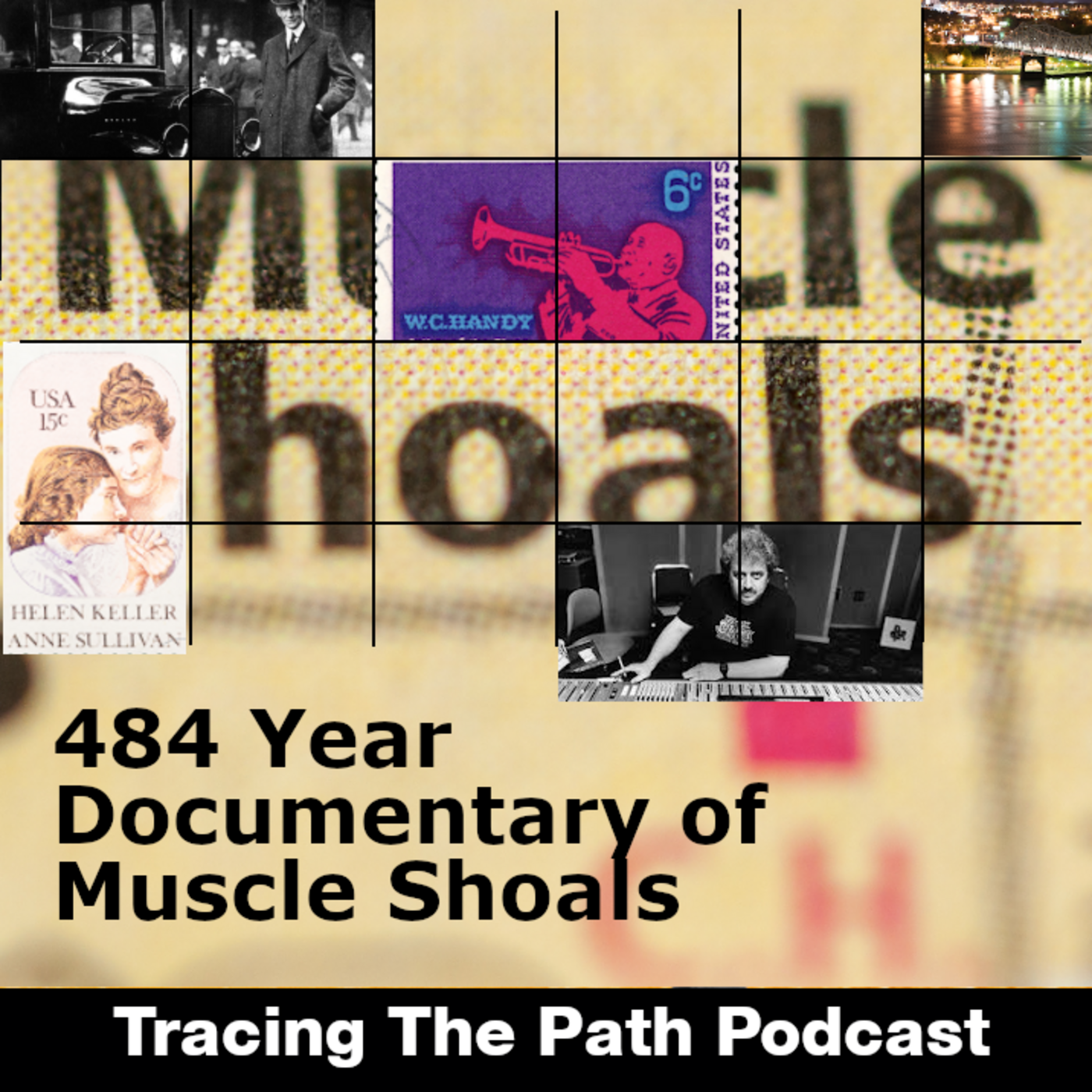
484 Year Documentary of Muscle Shoals
This episode embarks on a journey through American history, culture, and innovation, particularly highlighting the profound impact of the Muscle Shoals region of Alabama. It interweaves seemingly disparate narratives—from early Spanish exploration and Native American history to the birth of blues music and the development of hydroelectric power—to reveal how this specific geographical location became a nexus for remarkable events and individuals.
The story emphasizes the resilience and ingenuity of figures like Helen Keller, whose extraordinary life and advocacy are traced back to her family’s roots in the shoals, and pioneers like W.C. Handy and Sam Phillips, who were instrumental in shaping American music, particularly the blues and early rock and roll, from this unexpected hub. Ultimately, “Muscle Shoals” demonstrates how a single location can be a microcosm for broader themes of human struggle, artistic expression, and technological advancement throughout history.

Audio Hour:
If you run an activity group, classroom or “audio book club”, click here for more information on using Tracing The Path.
Throughout the episodes, every tune is somehow related to the topic. In the Twinkies episode, for instance, the discussion of the Brooklyn Tip-Tops Baseball team concludes with “Take Me Out To the Ballgame”.
How many do you recognize? And harder, how many can you name?
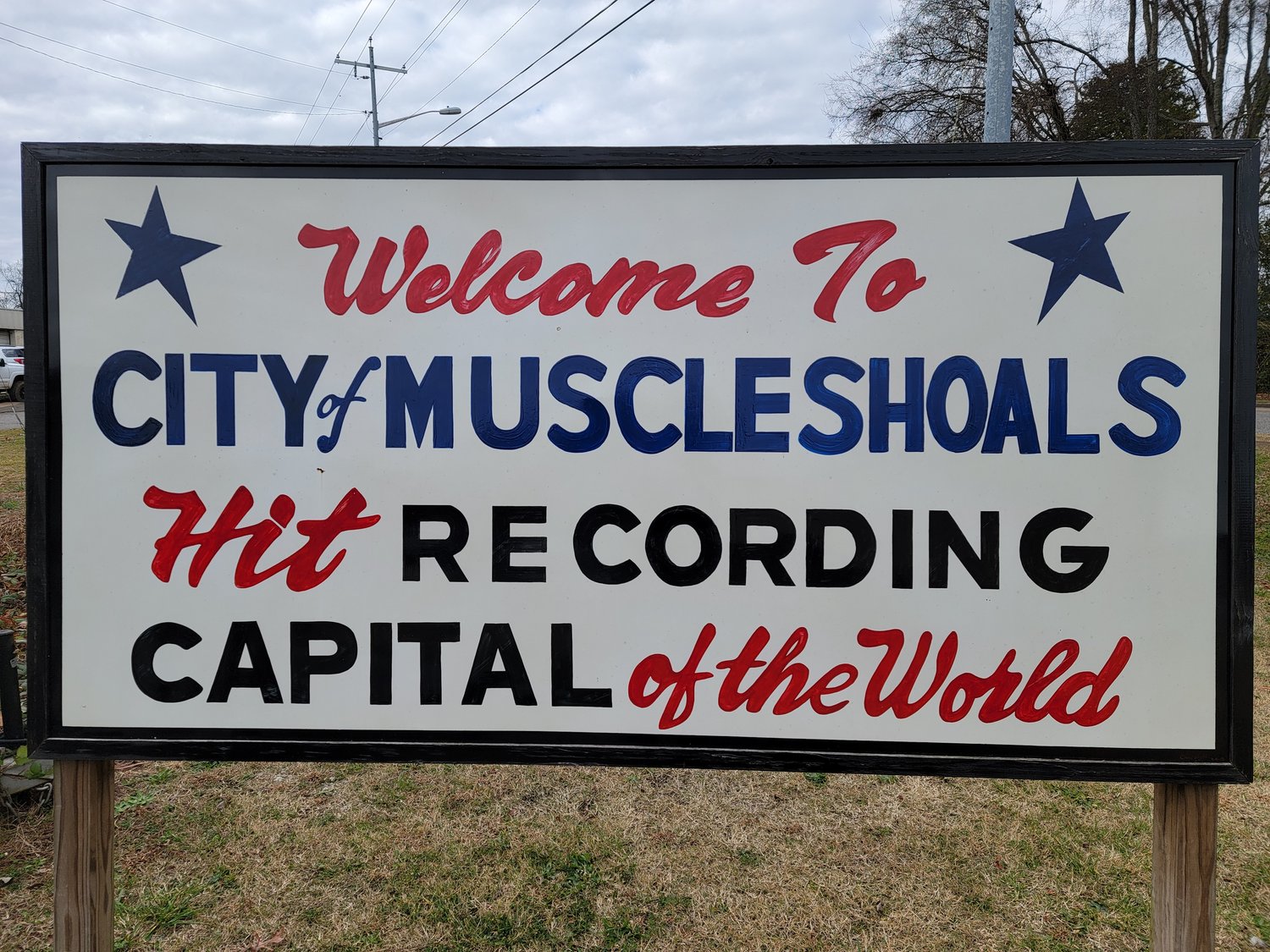
Muscle Shoals
Stop Action Animation is not used much anymore, with the proliferation of CGI of course. But there was a time that a movie maker would make a character out of clay, then would move the character ever so slightly and would take a picture. Then move it again and take another picture. Hundreds of pictures later, the individual images, on a movie role, would create magic. In fact, stop action is the way Disney made movies like Winnie the Pooh.
In today’s episode, we’re going to take snapshots of one place on Earth, and you’ll be amazed at what unfolds.
Our story begins back in the year 1500, when Spain’s King Ferdinand sent explorers to America in search of gold. His instructions were to get gold humanely if you can, but at all hazards get gold.
Spanish explorers heeded the call, and Juan Ponce de Leon claimed and named Florida for Spain.
In 1539, Hernandez de Soto followed in his sort of “Jeckyll and Hyde” mission across the south.
On one hand, he promoted Christianity to native populations, and on the other he killed thousands along the way. In addition, he brought slave labor on the trip, and demanded the Indians help carry his wares on the expedition.
Part of his trip traversed what is now known as northern Alabama. It is there he ran into a group of natives, he labeled the Chiskas. They were living near a rocky river and spoke a language like no other.
The Chiskas were found again by five Canadians who traveled to that same area in 1701. This time noting, the natives were living on an island in the river. These Canadians referred to them as the Yochi, not the Chiskas. These Yochi Indians lived all along the rocky shoals area of the river and had named it the Singing River because of the beautiful sound the water made across the rocks.
They lived there because enemy tribes could not attack by boat. The river was too rocky and the current too strong.
In 1816, European settlers arrived into the area saw no evidence of the Yochis, but instead found the river inhabited by the Chickasaw. They made trades with the Chickasaw in order to settle in that rocky river shoals area called Tuscumbia Valley by the Chickasaw.
By 1820, a federal road had made it to the area, increasing its importance as a trading area.
By 1850, a railroad was extended all the way there, with the stop being considered the Shoals of Alabama, and four communities began to develop, Tuscumbia, Sheffield, Florence, and Muscle Shoals.
With water, car, and train access, a trading center had been established.
Which brings us to the first hero of our story.
But for that, we must go back to 1775, to Casper Keller, a merchant in Zurich, Switzerland.
Helen Keller
As all Swiss are, Casper was a true patriot for the mother country, and his brother Heinrich was a source of pride for the family as well, as he had established the first school for the Deaf in Switzerland in 1786. Sadly that school wouldn’t last very long. Zurich was overrun by 45,000 French and 55,000 Austrians battling each other as part of the Napoleonic Wars. That school for the death was destroyed.
Casper, fortunately, had the foresight to leave Switzerland before the battle, migrating to Hagerstown, Maryland in the New World, near his father and mother who migrated to Pennsylvania long prior. There, Casper and his wife would start a family, their oldest son, they named David.
David Keller only knew America, and thus he grew up with the true American spirit of adventure. At 19 years old, he left Maryland to open a store in Knoxville. To make sure his store had the best merchandise, he pulled a wagon by horseback to Philadelphia, twice a year, to meet suppliers his father had cultivated.
On one of his trips, he met and fell in love with Mary Fairfax Moore. Mary’s father was Alexander Moore, the former aide to General Affair, and she was a second cousin to Robert E. Lee.
Mary and David wanted to start a family themselves and laid claim to land a few days ride west into Tuscumbia, Alabama, near the shoals of the river. And here is where our story begins to come together.
There they gave birth to Arthur Keller in 1836.
The Keller’s, as was custom in the region, brought on slave labor to work on the farm, and they became part of the fabric of the shoals of Alabama. Arthur grew up a Confederate at heart. He entered the University of Virginia in their law department and then enlisted as a private in the Confederate Army in 1861.
Arthur was assigned to various duties during the war including quartermaster and the Calvary and finished with the rank of Captain. After the war, Captain Keller returned practicing law on the shoals of Alabama and purchased the north Alabama newspaper where he remained the editor for 10 years.
In 1878, Captain Keller married Kate Adams and together they built a new home in the shoals called Ivy Green. Shortly thereafter, they gave birth to their first daughter, who through illness lost her hearing and her sight at 19 months old.
Her name was Helen. Helen Keller.
Charles Dickens the Saviour
For the first six years of Helen’s life, she lived without a voice and an utter darkness, fighting to be heard. And over the next two years her family would learn over 60 sign and movements she would make.
But her life would be changed by a most unexpected person, one of the most famous people in the world. Mr. Charles Dickens.
Charles Dickens was at the height of his popularity in 1842 after having written Nicholas Nickelby, Oliver Twist and the Pickwick Papers. That year, 1842, Dickens boarded the steamship Britannia in Liverpool, England bound for America to see for himself what made America so great.
Dickens found out that he was at the height of his popularity in America as well. He arrived in Boston on January 22nd and was mobbed by throngs of fans, much like you’d expect for four other boys from Liverpool. He would write home,
“I can do nothing that I want to do. Go nowhere I want to go and see nothing I want to see. If I turn into the streets, I am followed by the multitudes.”
One of the main goals of Dickens’ trip to America was to lobby America’s government for an international copyright law. Dickens works were largely pirated in America, and to his amazement, the press vilified him as a profiteer, and none of America’s authors and artists stepped up to second the cause.
He was also eager to compare public institutions to those in Britain, and so he visited prisons, hospitals, assylums, orphanages, schools for the blind, and factories. During his four months in the U.S., he went as far west as St. Louis and as far south as Richmond, Virginia.
He came away from the whole experience disappointed in America, writing,
“This is not the republic I came to see. This is not the republic of my imagination.”
Four months after his returned to England, he published the details of his disappointment in a book called American Notes.
46 years later, in 1886, Helen Keller’s mother would begin reading it.
In American Notes, Dickens was very critical and disgusted by slavery in the U.S. and more specifically in the White Attitudes towards slavery. His disgust actually changed his trip as he originally planned to go far south of South Carolina, but decided that Richmond he had seen enough.
In addition to his major disappointment with slavery, Helen’s mother read about Dickens’ visit to the Perkins Institution in Massachusetts, a school for the blind, where Dickens personally engaged with Laura Bridgeman, a blind and deaf girl who had remarkable communication skills from her education at the Perkins Institute.
It was from that book that she sent Helen and her husband to Baltimore to meet with a prominent physician. However, not well-versed in blind and deaf solutions, he recommend that Helen and her father meet with a local businessman, Alexander Graham Bell, who had been working with deaf children.
Alexander provided the recommendation Helen and her father needed.
Though it had been almost 50 years, the Perkins Institute was still the place to go. Alexander Graham Bell’s recommendation carried enormous weight as the school’s director asked Anne Sullivan if she would become Hellen’s teacher.
Anne Sullivan had been a star student at Perkins.
She had arrived in the US in 1866 after fleeing the Irish potato famine. When she was five, a bacterial infection took her sight. When she finally made it to the Perkins Institute, Laura Bridgman, whom Charles Dickens had met, had become her teacher.
So then on March 5, 1887, Anne Sullivan arrived in the shoals of Alabama to become Helen’s teacher. Helen, in her autobiography, called it “My Soul’s Birthday.”
For Helen’s parents, Anne’s arrival was both a blessing and a curse. She quickly bonded with Helen and started working with her right away. But she was also very critical of the Civil War and their slaves.
Anne and Helen worked together for a full year in Tuscumbia. But after the year was over, Anne convinced Helen’s parents that she needed a complete education, the kind you could only get at Perkins.
Her parents conceded and in 1888 Helen moved to Boston. Helen superior work at Perkins Institute led her to the Wright Humason School for the Death in 1894. At Wright- Humason, she had opportunity to meet the editor of Harper’s Bazaar magazine and was invited to a gathering at her house.
At that event, she met a lifelong fan of hers, world famous author Mark Twain, known by friends as Samuel Langhorne Clemens. Mark Twain had followed her journey through friends in media and was delighted to meet her, finding out about her academic goals Twain wanted to help.
He called his friend Henry Huddleston Rogers at the Standard Oil Corporation and asked if he and his wife would help finance the rest of Helen’s education. And that is precisely how Helen became the first deaf and blind person to get a bachelor’s degree and graduate from Radcliffe University.
Helen would go on to become a world famous speaker and author.
Because she was given all these opportunities, she wanted other families to have the same. The rest of her days would be in service of other disabled citizens, and solving the world’s inequalities.
In 1901, she started writing her life story, which was published in successive chapters in Harper’s Bazaar magazine, followed by the full book in 1903. She regularly spoke out about the evils of slavery, and even donated some of her public speaking money to the NAACP.
In 1920, she helped found the ACLU, and in 1924, the American Foundation for the Blind. She also helped women gain the right to vote and had met every president from Grover Cleveland to Landon Johnson.
All from her humble beginnings in Tuscumbia in the Schoals of Alabama.
Walking in Memphis
In 1888, just down the street from her, in Florence, lived William Christopher Handy, the son of an African Methodist Episcopal Church minister. Williams’ father had been a slave, but the emancipation proclamation sent him free, at which time he built a cabin for himself in the woods.
William caught the music bug early and learned to play the organ and the cornet. When he was older, he’d gotten a job at the local McNabb furnace on the shovel brigade. William loved the music the group made with their shovels alone and remembered long term how influential that was to his upbringing.
Nine years after Helen left the Shoals, William also left. He joined a band and played at the World’s Fair in Chicago and eventually settled down as a musician on Memphis’s Beale Street.
There he would do groundbreaking work combining the sounds of his childhood with the ragtime music and rock and roll of today.
In 1912 he self published the song “Memphis Blues” introducing the twelve bar blues to the world. Though it sold thousands, he didn’t make a dime from the effort. In debt to his printer, he had sold the tune to him for $50, and all of his unsold sheet music.
The printer added lyrics, reprinted it, and published it. William Christopher Handy would become famous under the name “WC Handy.” But the printer was the one who got rich.
“WC Handy’s Wealth” would come in 1914 when he published another song, St. Louis Blues, which sold millions. After the debacle he experienced with Memphis Blues and now his success with the St. Blues Blues, he understood the value of owning music and started buying songs from struggling musicians.
Then in 1921, Handy and his biz partner started the first black-owned record company, The Black Swan. W.C. Handy today is remembered as the father of the blues. He’s the first to bring the blues music to the mass American public.
In that same year, 1914, that he published St. Louis Blues. 1914 was also the year War War I came to the lives of Americans. And the government was digging deep to figure out what its risks were for this war.
Henry Ford & the Shoals
One of those risks was the supply of nitrates used to make explosives. The US had been importing nitrates from Chile, but they thought the Germans could at any point take out the ships, stopping the import.
During the Civil War, the Confederacy needed nitrates to make gunpowder. And with the northern blockades of southern ports, the south also could not import it. Instead, they had to mine it themselves.
And they did so, in caves in Virginia, as far as way as New Braunfels, Texas, and in the caves along the Tennessee River in the Shoals of Alabama.
But World War I was much too large a production for buckets and shovels and caves. The National Defense Act of 1916 called for the construction of two nitrate plants, powered by hydroelectric dams.
It was determined that the Tennessee River, where it passed through the shoals of Alabama, had the greatest hydroelectric potential east of the Rocky Mountains, which helps actually explain the name “Muscle Sholes.”
While the Youchi Indians called it the “Singing River” because of the sound of the rushing water that it made through the rocks, the town of Muscle Sholes was coined because of the energy you had to expend to paddle or muscle your way upstream.
Construction of the hydroelectric dam began in 1918 and was the largest installation at the time in the world. During its construction, over 18,000 workers descended upon the shoals of Alabama, erecting 1700 temporary buildings, six permanent ones, and miles and miles of sewer and electric cable.
The Wilson Dam, as it was named, would not be completed before the end of war, however, and didn’t contribute to nitrate production at all. After the war, the government wasn’t interested in continuing to fund projects like this, but it also didn’t want to throw away all the money it had already invested.
So in 1921, the Secretary of War, John Weeks, decided to explore private sector investment. His first stop was Henry Ford. Henry was one of the most famous and powerful men in America and personal friends with Woodrow Wilson.
Henry Ford agreed to take a look.
That year he and his friend and business associate Thomas Edison traveled to the shoals of Alabama to see what it could offer. They fell in love immediately.
The river, a federal highway, a train, a nearly completed hydroelectric plant, Ford saw a gold mine. He thought it could become the next Detroit. He told the local paper he could envision a 75 mile long city for over a million people. He thought it could be an innovative mix of city and farm life next to each other.
So he offered the government five million dollars for a ninety-nine year lease, which is equivalent to eighty-eight million dollars today. He promised to finish the dam but use it to produce nitrate fertilizer for farmers, and he’d insisted he’d build a second.
His offer created a surge of investment, larger than the Gold Rush did, and ushered in 138 new bills in Congress. On the ground in Muscle Shoals, investors streamed in buying up property buildings, laying sidewalks, and laying more sewer pipe.
But as it is with everything, it only took one person to muck up the works.
Senator George Norris of Nebraska didn’t like the idea at all. He didn’t like the government losing all that revenue after investing so much, and he didn’t like the idea of privatizing public utilities.
He lobbied that the government finished the dam itself and reaped the rewards, and thus a congressional battle began that dragged on and on and on. It dragged on so long, Henry Ford rescinded his offer in 1924 and walked away.
Ford’s actions brought new attention to the project again, and the government quickly came to consensus. And even that year, finished the dam. The dam generated electricity for the first time in 1925, and the higher water level created by the dam allowed free navigation of boats, high above the rocks that had previously prevented it.
In 1932, after the effects of the Great Depression were truly felt, the government created the Tennessee Valley Authority Public Works Plan to take over the dam. However, the Muscle Shoals in Henry Ford’s dream would just float away.
But the importance of the shoals of Alabama in American history would have two more roles to play.
Muscle Shoals Rock n Roll
Back in 1923, the year Ford made his $5 million offer. Samuel Cornelius Phillips was born in Florence in the Shoals of Alabama. He lived on a 200-acre farm and as a child, picked cotton in the fields, alongside his parents and black laborers.
The experience of hearing the black laborers sing as they picked cotton, left a big impression on him. And then when he was 19, Sam worked as an announcer at W. L. A. Y. Radio.
According to Sam, the station’s open format of broadcasting both white and black music would inspire him the rest of his career. In 1950, Sam left the Shoals of Alabama and moved to the big city of Memphis and opened the Memphis recording service.
He let amateurs come in and record, which drew performers like B.B. King, Junior Parker, and Hallelujah Wolf. It also brought in a group called Jackie Brenston and his Delta cats, to which they recorded the first rock and roll album ever.
Albeit, Jackie Breson and the Delta Cats actually had Ike Turner playing Sax in his band. From that moment Sam created his own label, “Sun Records Company.”
And then on July 18, 1953, a young 18-year-old boy came into the Memphis recording service to record some songs for his mother’s birthday. Marion Kiesker, the employee working that day, was so impressed by the young man she copied his album before he left so Sam could hear it.
After Sam heard it they invited him back and had him record “That’s Alright Mama” which they produced and distributed making this young man an overnight success. Sam Phillips of Florence, Alabama had just created Sun Records and founded the 18-year-old Elvis Presley.
He would go on to produce Roy Orbison, Jerry Lewis, Carl Perkins and Howlin Wolf, among others. Not bad for a boy growing up on the “Singing River”. Which brings us to the final hero of our story.
While growing up, Sam Phillips had a friend who was also musical, Rick Hall.
Rick Hall grew up a couple towns away from Sam to a sharecropper single dad and he lived with his grandfather. He found out early he loved music. As a teenager, he lived some time in Illinois with relatives playing in a band, but ultimately he went back to Alabama to be closer to his father.
There he worked at a factory nearby while playing music on the side. But the death of his father and his new bride, both in a two-week period in 1957, pushed him into heavy drinking and depression.
Instead of trying to hold down a job, he decided he tried his hand at writing songs instead and had some early success. George Jones recorded his song, “Achin Breakin’ Heart,” and Brenda Lee recorded, “She’ll Never Know,” and his friend Sam Phillips connected his song “Sweet and Innocent,” to Roy Orbison.
Rick’s success in songwriting led him to wanting a recording studio and record company of his own. His good friend Sam Phillips swayed him away from going to Nashville where he’d just be eaten up, but instead to stay right there in the Shoals of Alabama, so he opened Fame Recording Studio at first in Florence and then later moved to Muscle Shoals.
Rick’s idea was to gather some of his studio musician friends and record songs for artists. Rick wanted his Fame Studio to be a safe place for black and white artists to perform, despite the dangers at that time. In fact, in 1961, Alabama was racially a dangerous place.
The civil rights movement had been in full swing. Rosa Parks and the Montgomery bus boycott had just taken place a few hours south of the Shoals. Also, George Wallace was running for Governor of Alabama with the slogan “Segregation Forever” and was actually elected.
George Wallace himself stood in front of school buildings blocking black children from entering.
Race relations in Alabama were tenuous at best. Charles Dickens would have rolled his grave had he heard Governor Wallace’s acceptance speech.
“In the name of the greatest people that have ever trod this earth, I draw the line in the dust and toss the gauntlet before the feet of tyranny, and I say, “Segregation now, segregation tomorrow, segregation forever.”
But Rick was not deterred by such ignorance, and one of his first recordings was with Arthur Alexander, a black musician, whose song “You Better Move Me” became a number one hit, and Muscle Shoals his first gold record.
If only King Ferdinand and her Hernandez de Soto had waited another 461 years, they had found the gold they were looking for.
Arthur Alexander’s song on the Billboard charts caught the attention of the industry. The studios in Memphis, Nashville and Detroit had a distinct sound. Rick Hall’s group was bringing something new and intriguing.
After a string of hits, like “What Kind of Fool” by the Thames, and “When A Man Loves a Woman” by Percy Sledge, reached number one on both the R&B and Pop Tarts, Fame Studios Aretha Franklin arrived as a gospel artist looking for her sound. And at fame, she found her groove.
Most of America would have been surprised her first hit. “I never loved the man the way I love you” happened in the Jim Crow South. When Wilson Pickett was flying in and saw black laborers picking cotton in the fields below, he didn’t want to get off the plane. But when he did arrive at Rick Hall’s safe studio, he recorded Mustang Sally, Funky Broadway, and Land of a Thousand Dances.
Clarence Carter famously quipped, “Fame Studio was the only place in South Icould call a white man by his first name.”
Otis Redding, Ray Charles, the Osmonds, and many more graced the steps of fame studios.”
Helen Keller would only get to hear Aretha Franklin’s first song, and it isn’t known if Helen was aware that the song was recorded in her own town.
Helen passed away in 1968, but not before giving the world a musical gift of her own.
Remember Heinrich Keller, Helen’s distant relative who opened the first school for the Deaf and Zurich?
He did so, five years before Beethoven lost his hearing himself. Totally deaf in 1824, Beethoven completed his ninth symphony, and unveiled it to the world with Franz Schubert listening in the audience.
It was the first major composition to include a chorus, and for that, he chose to use the words of the poem, “Ode to Joy” by Shiller.
Exactly 100 years later, Helen Keller got to hear her performance by the New York Symphony Orchestra at Carnegie Hall. She listened by putting her hands up to a speaker as they played Beethoven’s 9th.
She was so moved by the performance, she wrote this letter to the symphony.
“Dear friends, I have the joy of being able to tell you that, though deaf and blind, I spent a glorious hour last night listening over the radio to Beethoven’s ninth symphony. I do not mean to say that I heard the music in the sense that other people heard it, and I do not know whether I can make you understand how it was possible for me to deprive pleasure from the symphony. It was a great surprise to myself. I had been reading in my magazine for the blind of the happiness that the radio was bringing to the cyclist everywhere. I was delighted to know that the blind had gained a new source of enjoyment, but I did not dream that I could have had any part in their joy.
Last night, when the family was listening to your wonderful rendering of the immortal symphony, someone suggested that I put my hand on the receiver and see if I could get any of the vibrations. He unscrewed the cap and I lightly touched sensitive diaphragm. What was my amazement to discover that I could feel, not only the vibrations, but also the impassioned rhythm, the throb and the urge of the music. The intertwined and intermingling vibrations from different instruments enchanted me.
I could actually distinguish the Coronets, the role of the drums, deep-toned violas and violins singing an exquisite unison, have a lovely speech of the violins flowed and plowed over the deepest tones of other instruments. When the human voice leaped up, trialing from the surge of harmony, I recognized them instantly as voices.
I felt the chorus grow more exultant, more ecstatic, up-curving swift and flamelike, until my heart almost stood still. The women’s voices seemed an embodiment of all the angelic voices rushing in a harmonious flood of beautiful and inspiring sound. The great chorus throbbed against my fingers with poignant pause and flow.
Then all the instruments and voices together burst forth, an ocean of heavenly vibration, and died away like winds when the atom is spent, ending in a delicate shower of sweet notes. Of course this was not hearing, but I do know that the tones and harmonies conveyed to me, moods of great beauty and majesty.
I also sensed where I thought I did, the tender sounds of nature that sing into my hand, swaying reeds and winds in the murmur of streams. I have never been so unwraptured before by a multitude of toned vibrations. Let me thank you warmly for all the delight which your beautiful music has brought to my household and to me. I want to thank Station W.E.A.F. for the joy they are broadcasting in the world, with warmest regards and best wishes.
I am Helen Keller.”
But what Helen probably didn’t know was that Shiller’s poem, “Ode to Joy”, included by Beethoven in the symphony, represents the triumph of universal brotherhood against war and desperation.
Rick Hall, Sam Phillips, W.C. Handy, Aretha Franklin and Clarence Carter would agree with these translated lyrics from the poem.
Thy magic power reunites
All that custom has divided;
All men become brothers
Under the sway of thy gentle wings.
1501, 1700, 1824, 1865, 1924, 1961.
All snapshots of a singular place on earth, but when you put them together, the story of Muscle Shoals, and the shoals of Alabama, is one of pure magic.
CUTTING ROOM FLOOR
To hear all the stories that hit the cutting room floor, you have to listen to the episode.
ABOUT THE SHOW
Let us tell you the story of the 20th Century, by tracing each event back to the original decisions that shaped it. You’ll quickly find out that everybody and everything is connected. If you thought you understood the 20th Century, you’re in for a treat.
Tracing the Path is inspired by storytellers like Paul Harvey, Charles Kuralt, and Andy Rooney.
INTERCONNECTED EPISODES
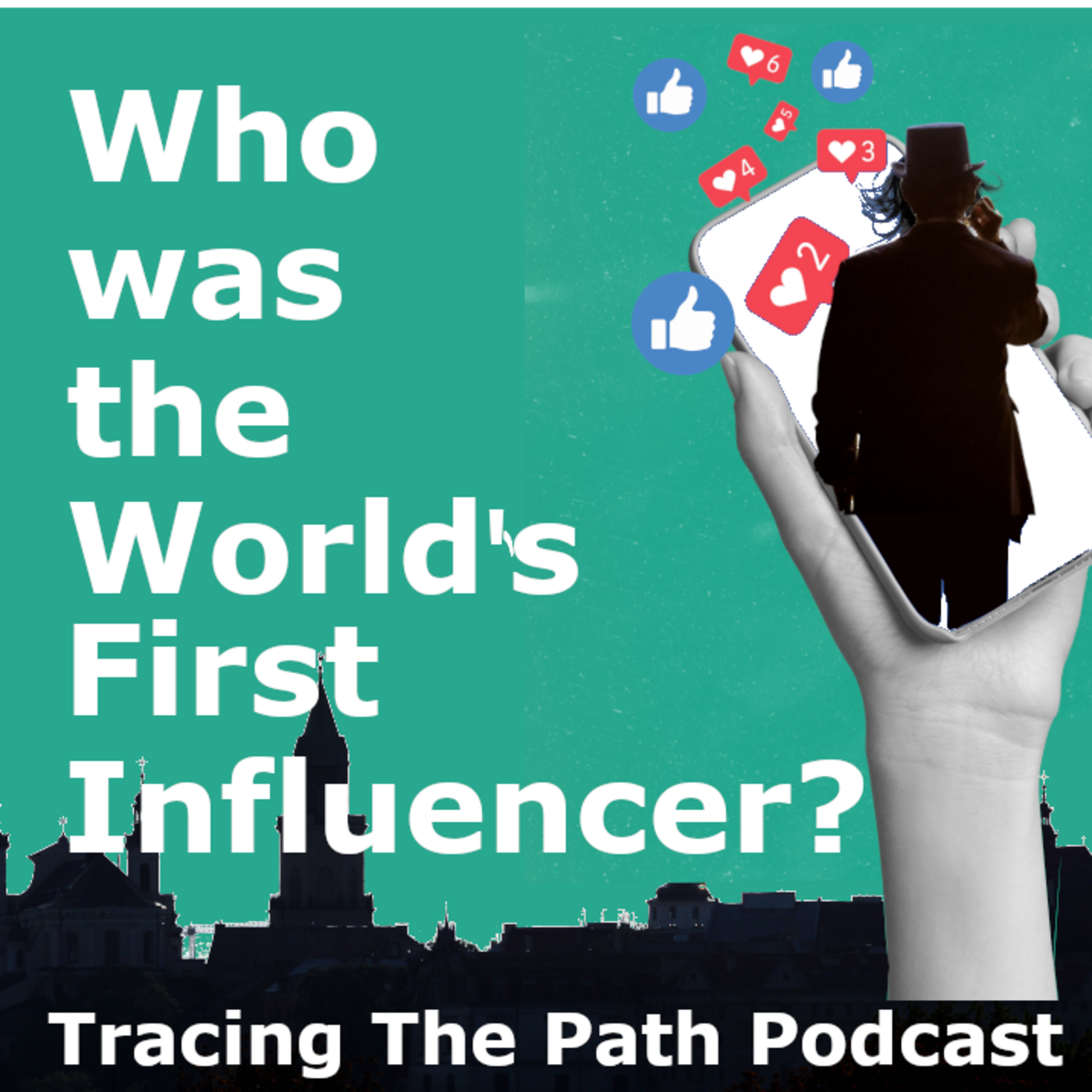 |
Was Dickens the First Influencer? When Charles Dickens came to America, he found throngs of people waited for every word he said. |
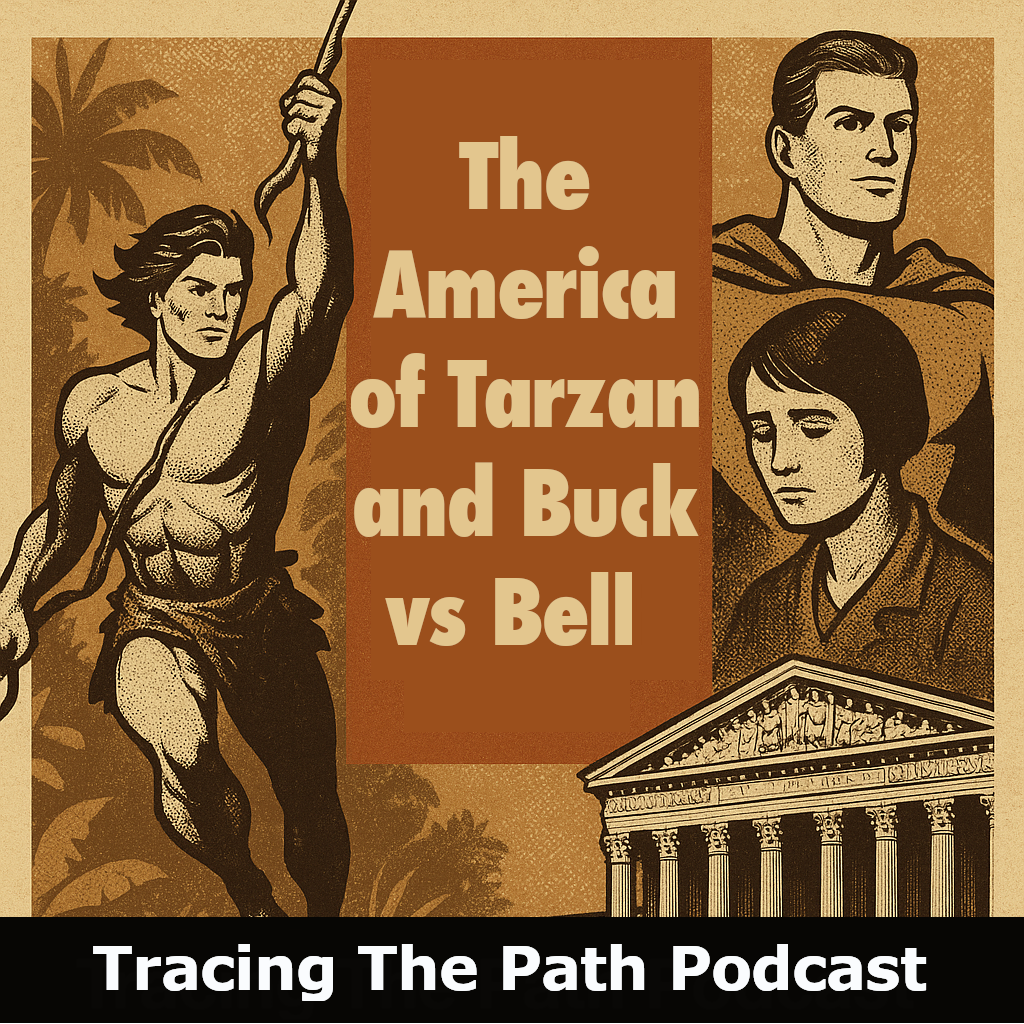 |
Tarzan and Buck vs Bell From the he national culture came the Superhero Tarzan and America’s worst piece of legislation. |
 |
The Comet That Saw it All The actual significance of Halley’s Comet |
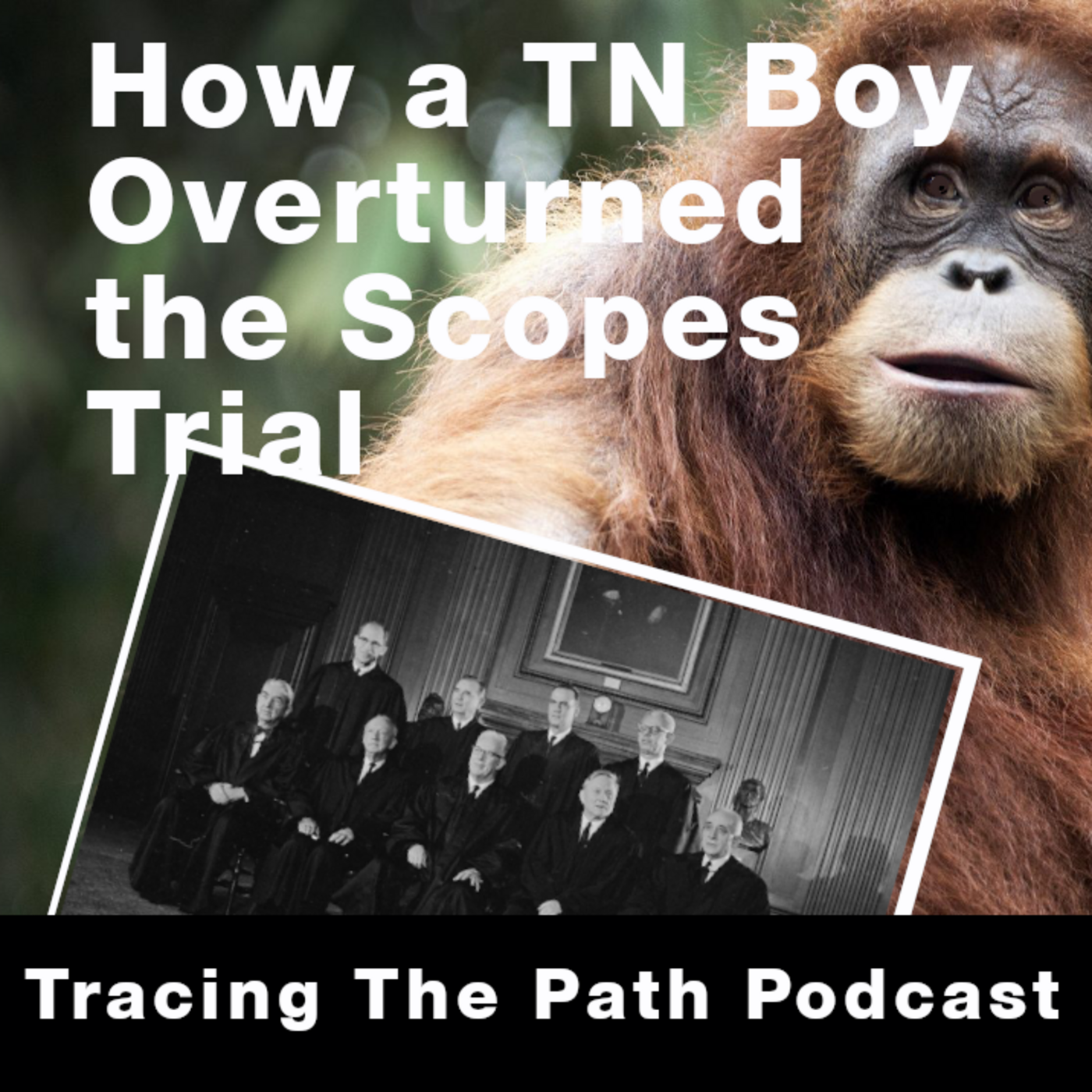 |
How a Tennessee Student Overturned the Scopes Trial Verdict Can you believe the 1925 Scopes Trial was undermined by a Tennessee high school senior? |
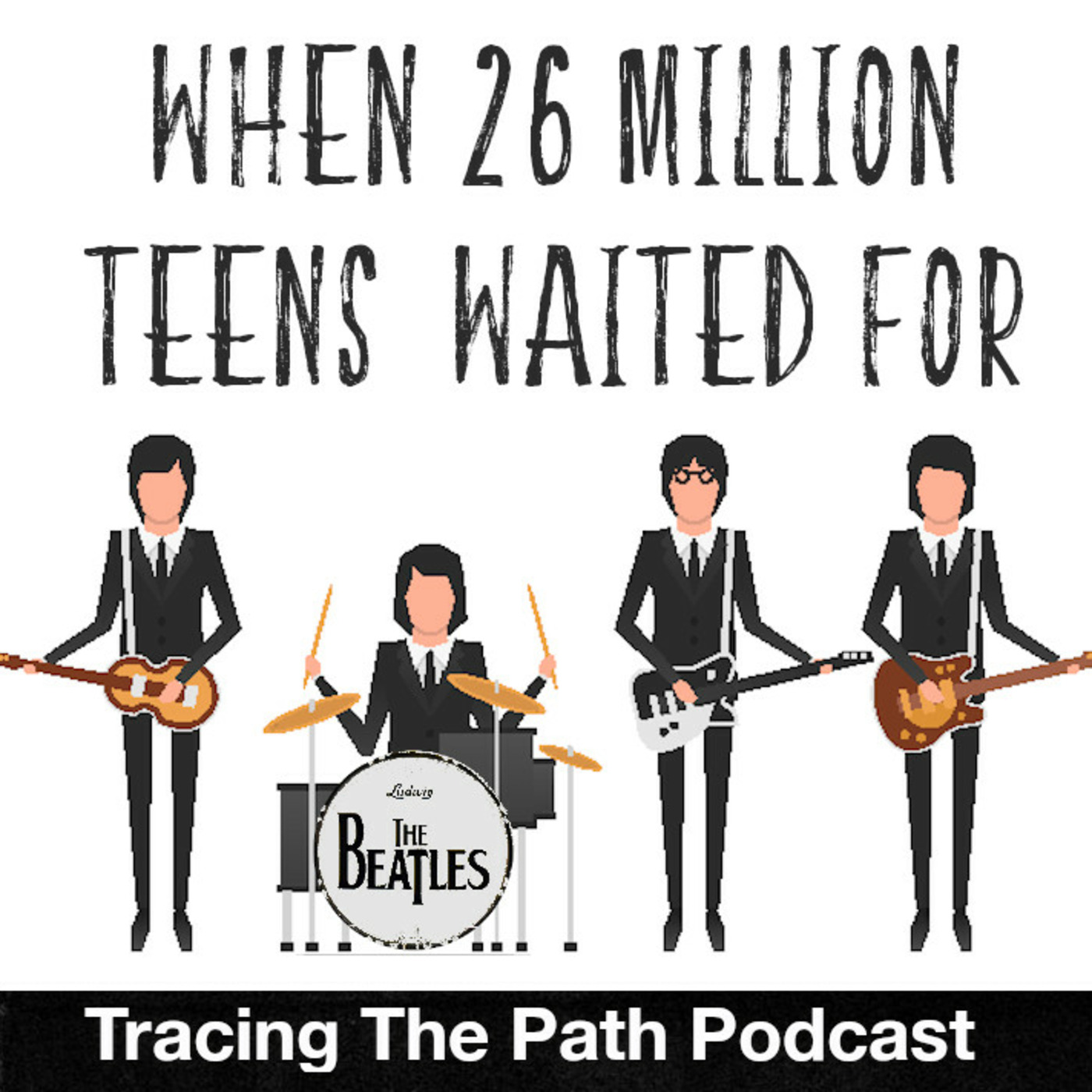 |
When 26 Million Teens Waited for the Beatles The phenomenon that occurred when the Beatles were live on the Ed Sullivan show could have been predicted. . . |
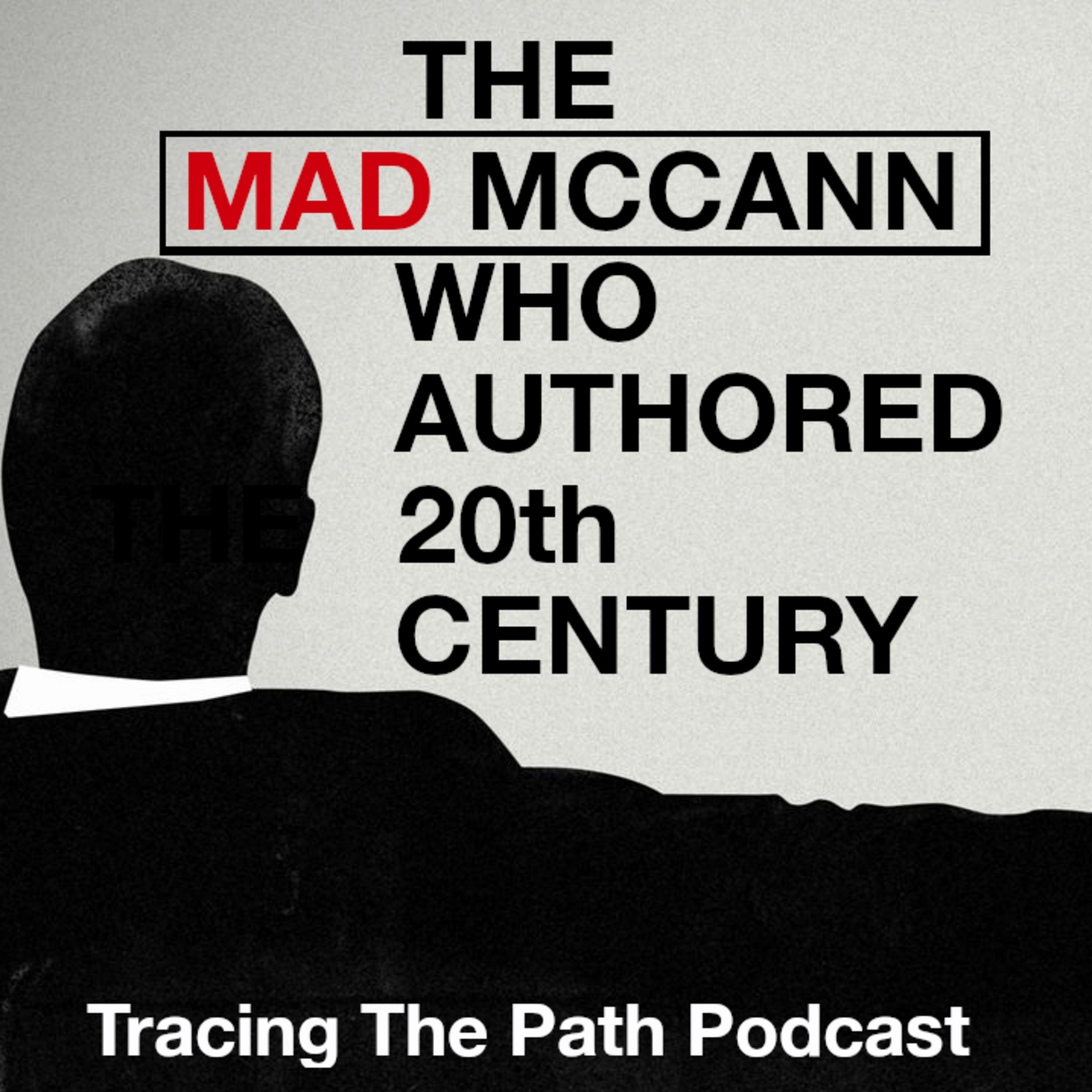 |
The History and Impact of McCann Erickson You’ll be amazed at how many things in our world come back to McCann. |
SEE THE BIBLIOGRAPHY
SUBSCRIBE AND LISTEN (FOR FREE!)
RATINGS & REVIEWS
If you enjoy this podcast, please give it a rating and review.Positive ratings and reviews help bring Tracing The Path to the attention of other history lovers who may not be aware of our show.



